






Wednesday 9 October, 7.30pm Ayr Town Hall
The Ayr concert is subsidised by The Scottish Children's Lottery Trust, Destination South Ayrshire, and Ayr Arts Guild.
Thursday 10 October, 7.30pm, The Queen's Hall, Edinburgh
Friday 11 October, 7.30pm, City Halls, Glasgow
POULENC Concert champêtre
STRAVINSKY Suite, Pulcinella
Interval of 20 minutes
VIVALDI Concerto in D minor Op 3 No 11, RV 565 ‘L’estro Armonico’ RAMEAU Suite, Les Boréades
Maxim Emelyanychev Conductor
Stephanie Gonley Violin
Marcus Barcham-Stevens Violin
Philip Higham Cello
Maxim Emelyanychev

4 Royal Terrace, Edinburgh EH7 5AB
+44 (0)131 557 6800 | info@sco.org.uk | sco.org.uk
The Scottish Chamber Orchestra is a charity registered in Scotland No. SC015039. Company registration No. SC075079.
THANK YOU
Our Principal Conductor’s Circle are a special part of our musical family. Their commitment and generosity benefit us all – musicians, audiences and creative learning participants alike.
Annual Fund
James and Patricia Cook
Visiting Artists Fund
Colin and Sue Buchan
Harry and Carol Nimmo
Anne and Matthew Richards
International Touring Fund
Gavin and Kate Gemmell
Creative Learning Fund
Sabine and Brian Thomson
Conductor Emeritus Joseph Swensen
Donald and Louise MacDonald
Chorus Director Gregory Batsleer
Anne McFarlane
Principal Second Violin
Marcus Barcham Stevens
Jo and Alison Elliot
Second Violin Rachel Smith
J Douglas Home
Principal Viola Max Mandel
Ken Barker and Martha Vail Barker
Viola Brian Schiele
Christine Lessels
Viola Steve King
Sir Ewan and Lady Brown
Principal Cello Philip Higham
The Thomas Family
Sub-Principal Cello Su-a Lee
Ronald and Stella Bowie
American Development Fund
Erik Lars Hansen and Vanessa C L Chang
Productions Fund
Anne, Tom and Natalie Usher
Bill and Celia Carman
Anny and Bobby White
Scottish Touring Fund
Eriadne and George Mackintosh
Claire and Anthony Tait
Cello Donald Gillan
Professor Sue Lightman
Cello Eric de Wit
Jasmine Macquaker Charitable Fund
Principal Double Bass Nikita Naumov
Caroline Hahn and Richard Neville-Towle
Principal Flute André Cebrián
Claire and Mark Urquhart
Principal Oboe Robin Williams
The Hedley Gordon Wright Charitable Trust
Principal Clarinet Maximiliano Martín
Stuart and Alison Paul
Principal Bassoon Cerys Ambrose-Evans
Claire and Anthony Tait
Principal Timpani Louise Lewis Goodwin
Geoff and Mary Ball


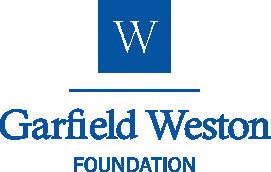
Diamond
Malcolm and Avril Gourlay
John and Jane Griffiths
James and Felicity Ivory
Robin and Catherine Parbrook
Tom and Natalie Usher
Platinum
Michael and Simone Bird
Silvia and Andew Brown
David Caldwell in memory of Ann
Dr Peter Williamson and Ms Margaret Duffy
Judith and David Halkerston
Audrey Hopkins
David and Elizabeth Hudson
Helen B Jackson
Dr and Mrs Peter Jackson
Dr Daniel Lamont
Chris and Gill Masters
Duncan and Una McGhie
Anne-Marie McQueen
James F Muirhead
Patrick and Susan Prenter
Mr and Mrs J Reid
George Ritchie
Martin and Mairi Ritchie
Hilary E Ross
Elaine Ross
George Rubienski
Jill and Brian Sandford
Michael and Elizabeth Sudlow
Robert and Elizabeth Turcan
Alan and Sue Warner
Finlay and Lynn Williamson
Ruth Woodburn
William Zachs
Gold
Peter Armit
Adam Gaines and Joanna Baker
John and Maggie Bolton
Elizabeth Brittin
James Wastle and Glenn Craig
Jo and Christine Danbolt
James and Caroline Denison-Pender
Andrew and Kirsty Desson
David and Sheila Ferrier
Chris and Claire Fletcher
Dr J W E Forrester
James Friend
Iain Gow
Margaret Green
Christopher and Kathleen Haddow
Catherine Johnstone
Gordon Kirk
Janey and Barrie Lambie
Mike and Karen Mair
Roy and Svend McEwan-Brown
John and Liz Murphy
Maggie Peatfield
Charles Platt
Alison and Stephen Rawles
Andrew Robinson
Olivia Robinson
Anne McAlister and Philip Sawyer
Irene Smith
Ian S Swanson
Ian and Janet Szymanski
John-Paul and Joanna Temperley
Bill Welsh
Robert Mackay and Philp Whitley
Catherine Wilson
Neil and Philippa Woodcock
G M Wright
Silver
Roy Alexander
Fiona and Neil Ballantyne
The Batsleer Family
Jack Bogle
Jane Borland
Michael and Jane Boyle
Mary Brady
John Brownlie
Laura Buist
Robert Burns
Kate Calder
Sheila Colvin
Lorn and Camilla Cowie
Lord and Lady Cullen of Whitekirk
Adam and Lesley Cumming
Dr Wilma Dickson
Sylvia Dow
Raymond Ellis
Dr and Mrs Alan Falconer
Sheila Ferguson
Malcolm Fleming
Dr William Irvine Fortescue
Dr David Grant
Andrew Hadden
J Martin Haldane
Ronnie and Ann Hanna
Roderick Hart
Norman Hazelton
Ron and Evelynne Hill
Philip Holman
Clephane Hume
Tim and Anna Ingold
David and Pamela Jenkins
Margaret Mortimer and Ken Jobling
Julie and Julian Keanie
Professor Christopher and Mrs Alison Kelnar
Dr and Mrs Ian Laing
Graham and Elma Leisk
Geoff Lewis
Christopher and Molly Ludlam
Dorothy A Lunt
Vincent Macaulay
James McClure in memory of Robert Duncan
Gavin McCrone
Brian Miller
Alistair Montgomerie
Andrew Murchison
Pamela Andrews and Alan Norton
David and Tanya Parker
John Peutherer in memory of Audrey Peutherer
James S Potter
Timothy Barnes and Janet Sidaway
Catherine Steel
Takashi and Mikako Taji
Douglas and Sandra Tweddle
C S Weir
Susannah Johnston and Jamie Weir
We are indebted to everyone acknowledged here who gives philanthropic gifts to the SCO of £300 or greater each year, as well as those who prefer to remain anonymous.
We are also incredibly thankful to the many individuals not listed who are kind enough to support the Orchestra financially on a regular or ad hoc basis. Every single donation makes a difference.
Become a regular donor, from as little as £5 a month, by contacting Hannah Wilkinson on 0131 478 8364 or hannah.wilkinson@sco.org.uk.
“A crack musical team at the top of its game.”

HM The King
Patron
Donald MacDonald CBE
Life President
Joanna Baker CBE
Chair
Gavin Reid LVO
Chief Executive
Maxim Emelyanychev
Principal Conductor
Andrew Manze
Principal Guest Conductor
Joseph Swensen
Conductor Emeritus
Gregory Batsleer
Chorus Director
Jay Capperauld
Associate Composer
Our Musicians
Information correct at the time of going to print
First Violin
Stephanie Gonley
Afonso Fesch
Sijie Chen
Kana Kawashima
Aisling O’Dea
Fiona Alexander
Catherine James
Rachel Spencer
Second Violin
Marcus Barcham Stevens
Gordon Bragg
Rachel Smith
Sarah Bevan Baker
Niamh Lyons
Stewart Webster
Kirsty Main
Serena Whitmarsh
Viola
Max Mandel
Zoë Matthews
Brian Schiele
Steve King
Cello
Philip Higham
Su-a Lee
Donald Gillan
Eric de Wit
Bass
Nikita Naumov
Jamie Kenny
Flute/Piccolo
André Cebrián
Marta Gómez
Oboe
Robin Williams
Katherine Bryer
Cor Anglais
Katherine Bryer
Clarinet
Maximiliano Martín
William Stafford
Bassoon
Cerys Ambrose-Evans
Alison Green
Horn
Steve Stirling
Jamie Shield
Andy Saunders
Rachel Brady
Philip Higham
Principal Cello
Trumpet
Peter Franks
Shaun Harrold
Trombone
Duncan Wilson
Tuba
Craig Anderson
Timpani
Louise Lewis Goodwin
Percussion
Iain Sandilands
Jack Fawcett
Alasdair Kelly
Lute
Alex McCartney Moore

POULENC 1899-1963)
Concert champêtre, FP 49 (1927–28)
Allegro molto – Adagio – Allegro molto
Andante: Mouvement de Sicilienne
Finale: Presto très gai
STRAVINSKY (1882-1971)
Suite, Pulcinella (1922)
Sinfonia
Serenata
Scherzino – Allegro – Andantino
Tarantella
Toccata
Gavotta
Vivo
Minuetto – Finale
VIVALDI (1678-1741)
Concerto in D minor Op 3 No 11, RV 565
‘L’estro Armonico’ (1711)
Allegro – Adagio e spiccato – Allegro
Largo e spiccato
Allegro
RAMEAU (1683-1764)
Suite, Les Boréades (c. 1763)
Ouverture
Suite des vents
Contredanses from Act I
Entrée d’Abaris
Menuets I & II
Contredanses
Composers have long looked back in time to the achievements of their musical predecessors for inspiration. It’s been happening – perhaps inevitably, certainly shamelessly – for centuries: you may have heard Mozart doff his cap to his predecessor JS Bach in the grand Mass in C minor last week.
But it was something that really took off in the early 20th century, and with good reason. A few decades earlier, the new classical music being created seemed to have got as big, opulent and questing as it could possibly become. For some composers, the only way forward was to go even further, break bonds with earlier musical traditions, and explore the expressive possibilities of (for example) key-less music. For others, however, the way forward was to look back: to the crisp precision, clarity and wit of music of the past, all elements that recent music had been sorely lacking.
These are all characteristics that seem to sum up the music of tonight’s opening composer, Francis Poulenc – with a bit of mischief thrown in, perhaps. ‘A musical clown of the first order’ was musicologist Martin Cooper’s description of Poulenc in his 1951 book French Music. Rather reductive, maybe, but it’s hard to refute that pithy assessment. There’s far more to Poulenc than simply fun and hijinks, however: the description of the composer as ‘half monk, half rascal’ by French critic Claude Rostande is probably closer to the mark.
Poulenc was a Parisian through and through, born into the comfort and security of a wellheeled family whose copious wealth had come from pharmaceuticals. Without the necessity of finding himself a job, the young Poulenc was able to devote himself to his
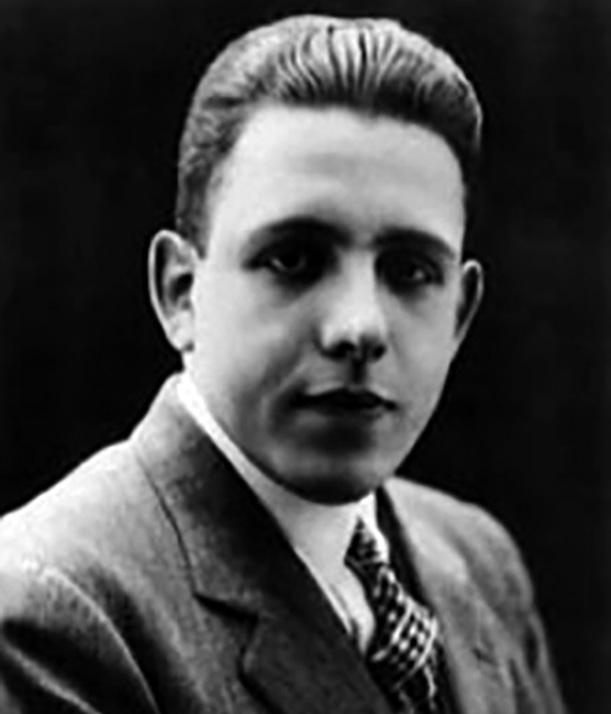
passion for music, and taught himself virtually unaided as a composer. He delighted in hanging out in Parisian bars and cafés as one of a loose composer collective dubbed Les Six (alongside Georges Auric, Louis Durey, Arthur Honegger, Darius Milhaud and Germaine Tailleferre), a gang that idolised Erik Satie and Jean Cocteau for their iconoclastic aesthetics, and gleefully stuck two fingers up at the serious-minded refinement of the French impressionist composers who had preceded them (though Poulenc maintained a quiet reverence for Claude Debussy).
Poulenc merrily pilfered influences from the music hall and the circus, from boulevard cafés and friteries, blending his sarcastic satire with a deep thread of heart-onsleeve sentimentality, both sides exquisitely delivered with sophistication and impeccable craftsmanship. Indeed, Poulenc succeeded in transforming the unabashed sentimentality of his earlier music into something entirely
Crisp precision, clarity and wit are characteristics that seem to sum up the music of tonight’s opening composer, Francis Poulenc – with a bit of mischief thrown in, perhaps.
sincere and genuinely moving in many of his later works, often his religious music. Raised a devout Catholic, he returned to explore his faith anew in works such as his solemn Stabat Mater and his deeply moving opera Dialogues des Carmélites, about the gruesome fate of a convent of nuns during the French Revolution.
But it’s another figure we need to consider when thinking about the origins of his 1928 Concert champêtre. The Polish-born, later French-resident Wanda Landowska was a legendary harpsichord player, and a major figure behind the renaissance of the instrument in the early 20th century. In the late 18th and 19th centuries, the harpsichord had struggled to compete with the louder, more powerful and subtler piano: composers turned away from it, and it slowly fell out of use. (There are even tales of the Paris Conservatoire smashing up its collection of unused, unloved harpsichords for firewood.)
Landowska, however, was among a small group of musicians who held a quietly radical viewpoint, believing that the music of the past should be played (and listened to) on the instruments for which it was originally written. Bach on the piano was all very well, and there was illustrious tradition of such performances. But since the modernday piano didn’t exist in his time, were music-lovers perhaps missing a trick by not considering its earlier keyboard cousin?
Landowska was indeed the first person to make a recording of Bach’s Goldberg Variations on the harpsichord, in 1933. It was one of many works of the past that she effectively resurrected through her championing of the instrument. But she was passionate, too, that there should be a modern-day repertoire for the harpsichord – a renaissance would be no good, after all, if all it could play’ was music from centuries ago. To that end, she commissioned several composers to write new harpsichord concertos for her – including Francis Poulenc.
Poulenc and Landowska first met in June 1923, when Landowska was performing as part of the ensemble in Manuel de Falla’s puppet opera El retablo de Maese Pedro at the Paris salon of Winnaretta Singer, the Princess of Polignac, the fabulously wealthy heiress to the Singer sewing machine fortune, and a generous supporter of the arts. Poulenc would later say that the meeting was one of the most important of his life: not only did it open up the possibilities of the harpsichord to him, but it also encouraged him to explore the earlier keyboard repertoire from his own country.
Landowska asked Poulenc for a concerto, and he quickly agreed. (She also asked Falla on the same occasion – but that’s another
story.) By that time, the harpsichordist was based in leafy Saint-Leu-la-Forêt to the north of Paris, where she taught and had established a centre for the study of early music. Poulenc travelled to see her there, and to discuss the new concerto in detail. So struck was he by the bucolic, pastoral setting that he christened his new work Concert champêtre, or ‘rustic concerto’.
The piece received its premiere on 3 May 1929 at Paris’ Salle Pleyel, with Landowska as soloist and Pierre Monteux conducting the Orchestre Symphonique de Paris. ‘I wanted to use the harpsichord in a manner that was both French, modern, and did not sound like a pastiche,’ the composer later observed. ‘I wanted to prove that the harpsichord was not an obsolete, inefficient instrument of merely historical interest.’
In true Poulenc-ian fashion, the Concerto blends the serious and the trivial, the sentimental and the sarcastic. But the composer also generally keeps his soloist and orchestra somewhat separate – perhaps aware that a modern-day orchestra might drown out the ancient instrument – although he’s savvy enough to exploit the harpsichord’s percussive possibilities, used to clatteringly effective use throughout the Concerto.
Stately, almost fanfare-like chords from woodwind and horns open the first movement, with a rather ascerbic response from the soloist, before they bring in the movement’s quicker, perkier main theme. The movement progresses almost as a succession of vivid but separate musical ideas, interrupted by sudden stops, a slower central section led by a strange, winding tune from the soloist, and plenty more. Finally, the original melody returns, and the harpsichord almost gets the final word.

Poulenc’s second movement is a Baroquestyle Sicilienne, with a distinctive dum-didum, dum-di-dum rhythm, famously used in centuries past to evoke pastoral idylls. Here, however, the minor key adds a sentimental, wistful feeling, and things darken considerably with the harpsichord’s abrupt cadenza, pitched low on the instrument, and mulling over a few angry phrases. So much so, in fact, that when the opening music returns even more opulently, it might feel like something more sinister is being concealed. Again, the harpsichord almost gets the last say.
The finale draws on the prancing, lively Baroque gigue form, in quick three time, with a rushing, dashing main theme interspersed with several contrasting episodes. A distinctive folk-like figure emerges (which sounds uncannily like something out of an early Stravinsky ballet), going on to become the main material for the Concerto’s final
Stravinsky was initially cool towards Diaghilev’s suggestion, but after perusing the material the impresario brought him, he became more interested: ‘I looked, and I fell in love,’ he later remembered.
section, before Poulenc – at last – allows the harpsichord the very final word.
If Poulenc celebrated the renaissance of an earlier instrument in his witty Concerto, tonight’s next piece is perhaps one of the most famous examples of a modern-day composer so inspired by earlier music that they decide to pilfer the lot.
Following the First World War and the flu pandemic that came hot on its heels, Igor Stravinsky had already begun downsizing his music from the lavish opulence of the three iconic scores for the Ballets Russes, the dance company founded by Russian impresario Sergei Diaghilev – The Firebird, Petrushka and The Rite of Spring. But he hadn’t particularly been focusing his attention on the music of earlier ages.
That change came thanks to Diaghilev, who was keen to emulate the roof-raising
success of these earlier ballets while luring Stravinsky back into the fold, having sensed a cooling in their working relationship. To do so, he suggested that the composer might consider writing a ballet score based on music he’d unearthed by Giovanni Pergolesi, the Italian composer who straddled the Baroque and Classical eras (about three decades before Haydn, in fact) despite living only to the age of 26. Also included in Diaghilev’s lure were the two men who would be Stravinsky’s collaborators on the project: dancer/choreographer Léonide Massine and designer Pablo Picasso.
Stravinsky was initially cool towards Diaghilev’s suggestion, but after perusing the material the impresario brought him, he became more interested: ‘I looked, and I fell in love,’ he later remembered. Massine came up with the ballet’s storyline during a visit to Naples in 1917, where he discovered the play The Four Pulcinellas, celebrating the traditional comic hero of the Neapolitan commedia dell’arte. The final preposterous plot involves four young women, all of whom are in love with the somewhat grotesque Pulcinella, and the jealousy of the women’s lovers, who set out to murder him. When they appear to have succeeded, each man disguises himself as Pulcinella and sets off to re-woo his own particular sweetheart. A magician arrives to reanimate Pulcinella’s corpse, which turns out to be someone else entirely. The magician reveals himself as Pulcinella, and sets about repairing the romantic rifts he’s caused.
Pulcinella was premiered on 15 May 1920 at the Paris Opéra, to immediate and lasting acclaim. Nonetheless, the journey from conception to premiere wasn’t smooth. Diaghilev is reported to have been somewhat shocked by Stravinsky’s
treatment of the music he’d given him (which, it later emerged, was a mix of Pergolesi and works by contemporaries or imitators, including Domenico Gallo, Fortunato Chelleri, Carlo Monza and the 19th-century Alessandro Parisotti). Diaghilev was expecting a rather tame, affectionate rescoring, but what he received was something quite different, to the extent that he realised he needed to credit Stravinsky as outright composer rather than simply arranger. Stravinsky himself later admitted: ‘I was attacked for being a pasticheur, chided for composing “simple” music, blamed for deserting “modernism”, accused of renouncing my “true Russian heritage”. People who had never heard of, or cared about, the originals cried “sacrilege”: “the classics are ours. Leave the classics alone.” To them all, my answer was and is the same: you “respect”, but I love.’
Stravinsky’s score is indeed much more than a simple arrangement of the earlier music by Pergolesi (and others), and far more than simply pastiche. He generally retains the original works’ melodies and basslines, but allows himself free rein with the rest, introducing irregular rhythms, pungent harmonies, piquant instrumental timbres and uneven, quirky balances. The result is almost an aural (rather than optical) illusion, simultaneously 18th-century music viewed through the prism of 20th-century modernism, and also a decidedly 20thcentury work that pays affectionate homage to earlier styles.
Stravinsky admitted that Pulcinella was one of his favourites among his own pieces, and made good use of it, creating an orchestral suite in 1922, and suites for violin and piano, and for cello and piano, in 1925 and 1933 respectively. And without it – and
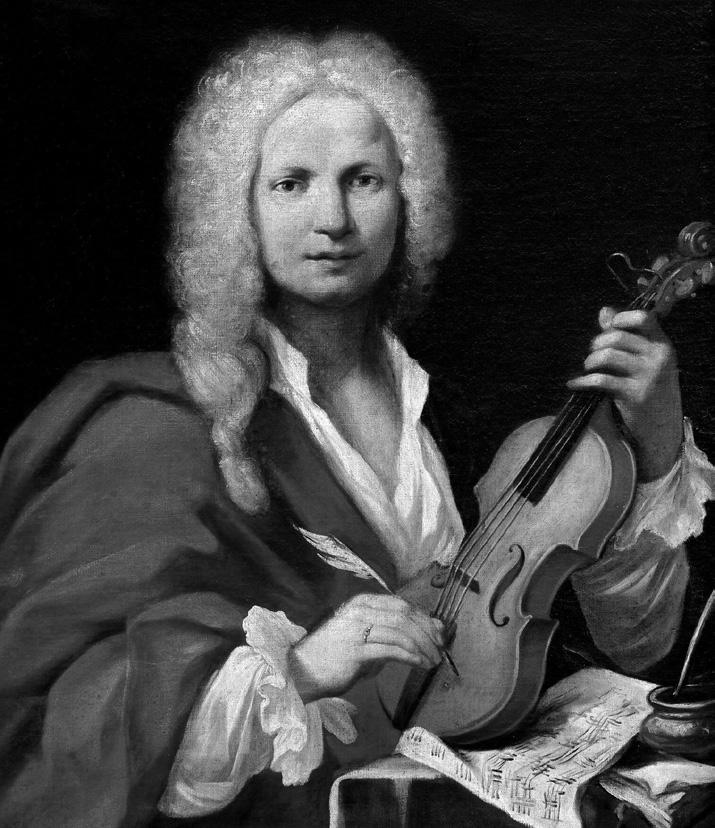
other historically informed music Stravinsky created around the same time – his later works would have been entirely different. He later wrote: ‘Pulcinella was my discovery of the past, the epiphany through which the whole of my late work became possible,’ also adding, ‘it was a backward glance, of course, but it was a look in the mirror, too.’
We jump back in time a couple of centuries for the final two pieces in tonight’s concert. And in the case of the first of them, to one of the very first concertos ever to be published.
That accolade goes to Antonio Vivaldi’s collection of 12 concertos Op 3, dubbed ‘L’estro armonico’ (or ‘Harmonic Inspiration’), published in Amsterdam in 1711. This newfangled way of disseminating music clearly worked: the concertos were an enormous success, and made the composer’s name right across Europe, with performances in churches and high-class homes, and even
It’s a piece that’s extremely brief by modern-day standards, but packs a lot into the few minutes it’s with us.
outdoor concerts involving more than 100 players.
The set brought together several concertos that Vivaldi had already written for Venice’s Ospedale della Pietà, where he worked for more than three decades. The institution is often referred to politely as an orphanage for girls, though the fuller picture is that it was a charitable institution for abandoned infants – in other words, the offspring of extra-marital liaisons by the great and the good of the city. (It even had a delivery window specially designed so that babies could be deposited without their carriers being identified.)
Nonetheless, music formed a central part of the Ospedale’s teaching, and its students were famed as breathtakingly accomplished musicians. Vivaldi wrote many of his more than 500 concertos specifically for the institution’s more advanced students, also
allowing younger players to gain experience in the pieces’ orchestras.
The 12 concertos of ‘L’estro armonico’ follow a repeating three-work format of a concerto for four violins, then one for two violins, and finally a solo violin concerto. No 11, therefore, is for two violins and orchestra. It’s a piece that’s extremely brief by modernday standards, but packs a lot into the few minutes it’s with us.
Vivaldi opens his first movement with a somewhat hypnotic duet for his two violins alone, before introducing a cello soloist from the orchestra. After a brief slow section, the main bulk of the movement follows with a somewhat gruff theme from the cello that quickly rises through the orchestra. An extremely long-held note in the bass indicates that we’re fast approaching the movement’s conclusion.
As in Poulenc’s Concert champêtre earlier, Vivaldi styles his slower second movement as a siciliano (an Italian version of the earlier French Sicilienne), evoking pastoral bliss, although, again like Poulenc, he sets it in the wistful minor. The first violin soloist breaks away during the movement’s unfolding for a long, tear-jerking melody that leads the music to its grief-stricken close. In his far livelier final movement, Vivaldi uses just about every textural combination possible from his collection of instruments, including a section for just the violin soloists plus cello, and another extended solo for the first violinist. It quickly draws to its dramatic conclusion, however.
Jean-Philippe Rameau was one of the earlier French composers that Wanda Landowska suggested Poulenc should get to know – not least because Rameau was a particularly
influential, inventive and pioneering composer for the harpsichord. Indeed, you could justifiably argue that he pushed harpsichord music away from the stylised formality of the conventional Baroque suite of dance movements, and into far more modern-sounding repertoire, from pieces that directly imitated or evoked other things (such as ‘The Hen’, ‘The Savages’ inspired by seeing Native American performers in Paris, ‘The Call of the Birds’, even ‘The Cyclops’) or simply showed off a player’s virtuosity.
For tonight’s final piece, however, we turn to a form that Rameau dedicated himself to in the final period of his life, and which really made his name: opera. There was a particularly rich tradition of French opera in the 18th century, and one with notable differences from its Italian counterparts. One difference was dance, virtually absent from Italian works, but central to French operas. French audiences adored spectacular choreographed scenes in their otherwise sung operas, and seemed perfectly content, too, with the virtually Wagnerian length that their operas ran to as a result. One useful byproduct of these 18th-century French tastes, however, is the wealth of instrumental dance music from French Baroque operas that can delight concert audiences today – including the movements we’ll hear tonight from Rameau’s final opera, Les Boréades
The extremely long-lived composer wrote the opera when he was in his late 70s, and died during rehearsals for its inaugural production in 1764, at the age of 80. As a result, the staging was shelved, and – remarkably – Les Boréades wasn’t given a stage production until as recently as 1982, conducted by John Eliot Gardiner at that year’s Aix-en-Provence Festival.

Its story blends Greek myth with certain Masonic ideas. Alphise, Queen of Bactria in central Asia, is in love with the mysterious foreigner Abaris, but she’s promised to a Boread, or a descendent of Boreas, god of the north wind. She abdicates her role so that she can wed her beloved Abaris, but Boreas is having none of it: he spirits her away to his kingdom so that he can decide what happens next. Abaris, however, enlists the help of Apollo to give chase – although in the opera’s dénouement, Apollo reveals that Abaris is actually his own son, thereby trumping Boreas in the godly hierarchy.
Perhaps not surprisingly, much of the music in the suite of instrumental pieces we hear this evening evokes the wind in one way or another. Horns and oboes summon the audience’s attention in the opening ‘Ouverture’, and it’s not long before breezy gusts appear in its more overtly melodic music. A gently flowing minuet in the central
The extremely long-lived composer wrote the opera when he was in his late 70s, and died during rehearsals for its inaugural production in 1764, at the age of 80. As a result, the staging was shelved, and – remarkably –Les Boréades wasn’t given a stage production until as recently as 1982.
section of the ‘Ouverture’ would have welcomed the characters on stage, and those gusting winds return for its faster closing music. Scurrying string figures perhaps suggest an impending storm in the ‘Suite des vents’, although they later calm to a light if persistent breeze.
A sprightly, unusually angular melody reappears again and again between contrasting episodes in the ‘Contredanses’ from the opera’s Act I, while the ‘Entrée d’Abaris’ introduces his noble character: notice the music’s descending melodic phrases, clearly setting him apart from the dashing, rising phrases that are so ubiquitous elsewhere. Two minuets represent dances between the allegorical figures of Love and Pleasure, while the closing ‘Contredanses’ –again for Love and Pleasure – are lively and perky.
© David Kettle

At the Scottish Chamber Orchestra Maxim Emelyanychev follows in the footsteps of just five previous Principal Conductors in the Orchestra’s 49-year history; Roderick Brydon (1974-1983), Jukka-Pekka Saraste (1987-1991), Ivor Bolton (1994-1996), Joseph Swensen (1996-2005) and Robin Ticciati (2009-2018).
Recent highlights have included a US tour and a performance at the London Proms with the Scottish Chamber Orchestra and his debuts with the Berliner Philharmoniker, New Japan Philharmonic, Osaka Kansai Philharmonic, Bergen Philharmonic, Finnish Radio Symphony Orchestra, Orchestre de Chambre de Paris.
In 2023/24 Maxim’s highlights included the following debuts: Symphonieorchester des Bayerischen Rundfunks, WDR Sinfonieorchester Köln, SWR Symphonieorchester Stuttgart, Deutsche Kammerphilharmonie Bremen, Toronto Symphony Orchestra, City of Birmingham Symphony Orchestra, Orchestre Philharmonique de Radio-France, Mozarteum Orchestra at the Salzburg Festival. He returns to the Deutsches Symphonie-Orchester Berlin, Royal Concertgebouw Orchestra, Rotterdam Philharmonic, Mahler Chamber Orchestra, Netherlands Philharmonic Orchestra, Orchestra of the Age of Enlightenment and the Swedish Radio Symphony Orchestra.
He regularly collaborates with renowned artists such as Max Emanuel Cenčić, Patrizia Ciofi, Joyce DiDonato, Franco Fagioli, Richard Goode, Sophie Karthäuser, Stephen Hough, Katia and Marielle Labèque, Marie-Nicole Lemieux, Julia Lezhneva, Alexei Lubimov, Riccardo Minasi, Xavier Sabata and Dmitry Sinkovsky.
Maxim is also a highly respected chamber musician. His most recent recording (on Aparté), of Brahms Violin Sonatas with long-time collaborator and friend Aylen Pritchen has attracted outstanding reviews internationally. With the Scottish Chamber Orchestra, Maxim has made critically-acclaimed recordings of Schubert Symphony No 9 – the symphony with which he made his debut with the orchestra – and Mendelssohn Symphonies Nos 3 'Scottish' and 5 'Reformation' both on Linn Records. Their latest recording, of Schubert Symphonies Nos 5 and 8, will be released in November.
For full biography please visit sco.org.uk
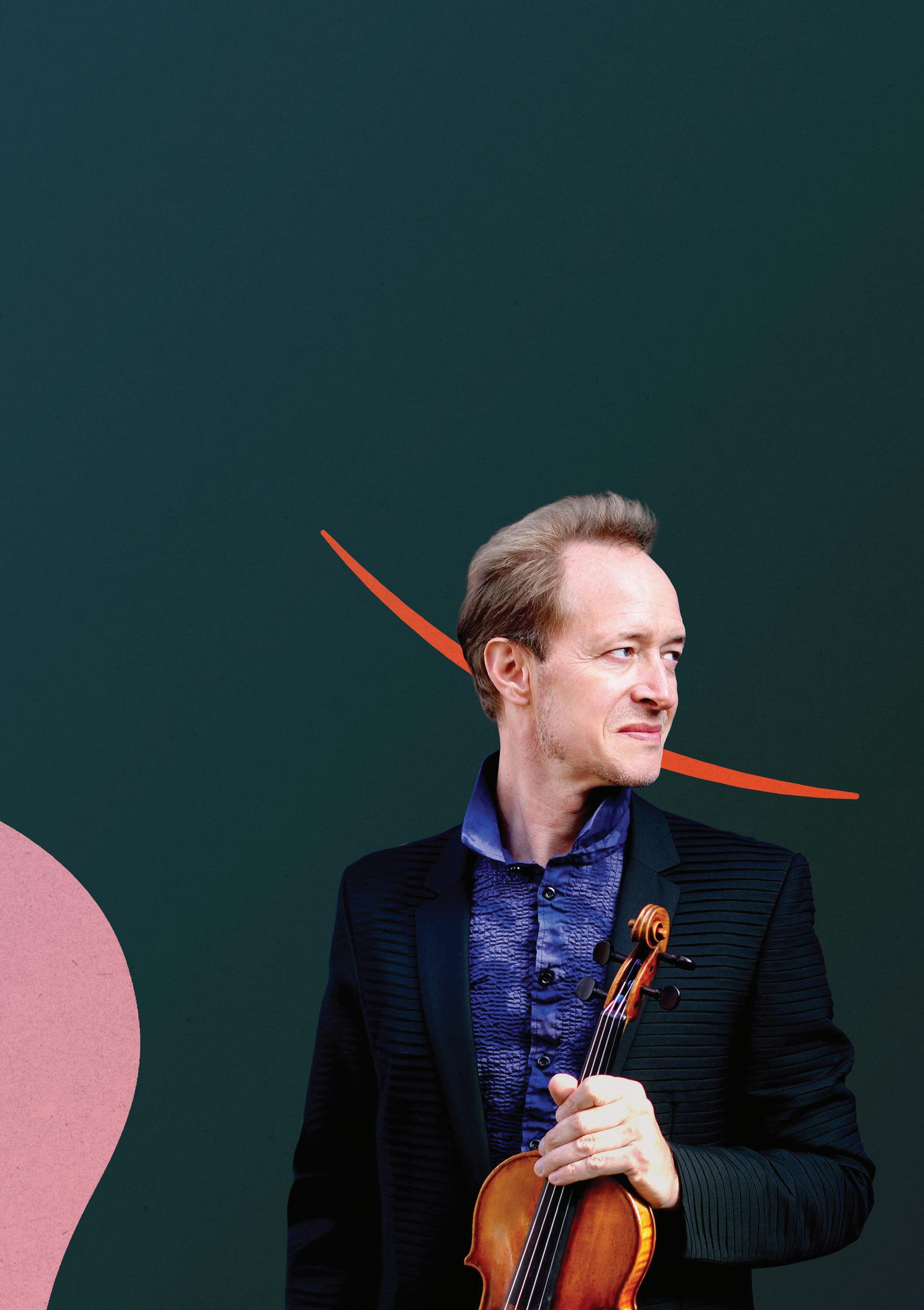

Stephanie has a wide-ranging career as concerto soloist, soloist/director of chamber orchestras, recitalist and a chamber musician. She has appeared as soloist with many of UK’s foremost orchestras, including the Royal Philharmonic Orchestra, London Philharmonic Orchestra, Philharmonia and BBC Symphony Orchestra.
Stephanie is leader of the English Chamber Orchestra and the Scottish Chamber Orchestra and has performed as Director/Soloist with both. Stephanie has also appeared as Director/ Soloist with the Australian Chamber Orchestra, the Vancouver Symphony, and the Oriol Ensemble Berlin to name but a few.
She has enjoyed overseas concerto performances with everyone from the Chamber Orchestra of Europe and Hannover Radio Symphony, to Hong Kong Philharmonic and the Norwegian Radio Symphony Orchestra, while her recordings include Dvorák Romance with the ECO and Sir Charles Mackerras for EMI, and the Sibelius Violin Concerto for BMG/ Conifer.
Stephanie is currently Professor of Violin at the Guildhall School of Music and Drama. She was a winner of the prestigious Shell-LSO National Scholarship.
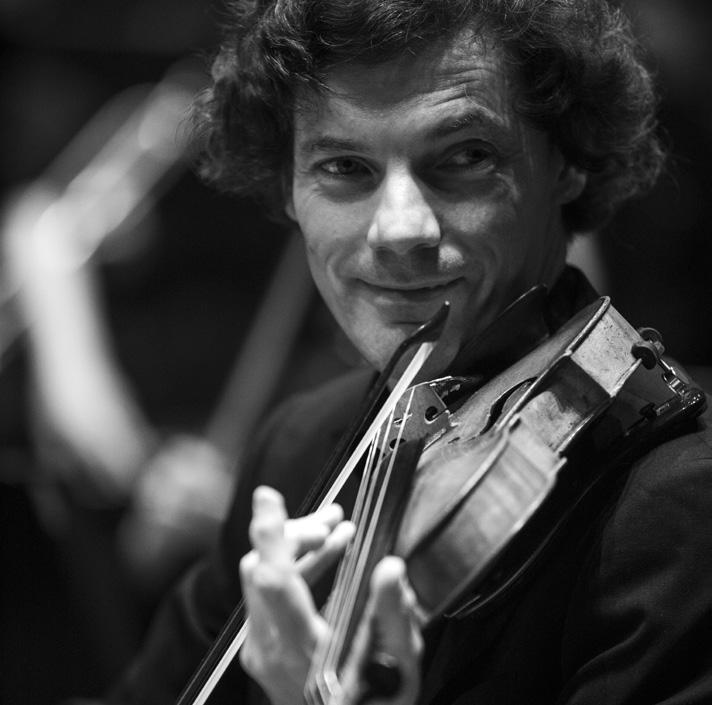
Marcus first played with the SCO in 2015 and joined in 2016. He has also been co-leader of the Britten Sinfonia since 2013. He was in the Fitzwilliam String Quartet for seven years, recording with them CDs of late quartets by Schubert and Shostakovich.
He has been invited as guest leader to the City of Birmingham Symphony Orchestra, Orchestra of the Age of Enlightenment, Aurora Orchestra and Royal Liverpool Philharmonic Orchestra, and played as Principal 2nd violin for Sir John Eliot Gardiner's Orchestre Révolutionnaire et Romantique.
As well as being broadcast as a soloist on BBC Radio 3, Marcus has enjoyed playing with groups including the Nash Ensemble, Arcangelo, King's Consort, Ensemble Modern, and the Birmingham Contemporary Music Group.
He also plays regularly with his wife, Scottish pianist Christina Lawrie. In March 2020, Christina and Marcus started their own concert series #ConcertFromOurLivingRoom, in which they performed fortnightly online concerts.
Marcus is also a composer and his piece Dhyana for soprano and Chroma ensemble was described as "hugely impressive" (George Hall, Guardian, 2011). He has written string quartets based on Purcell Fantasias for the Fitzwilliam String Quartet and choral anthems performed by the choir Ex Cathedra.
Marcus's Chair is kindly supported by Jo and Alison Elliot

Philip Higham enjoys a richly varied musical life: a passionate chamber musician, equally at home in concerto, duo and unaccompanied repertoire, he especially relishes Classical and German Romantic music, in which he is frequently and happily immersed as principal cellist of the SCO. He has appeared frequently in recital at Wigmore Hall and at other prominent venues and festivals both at home and abroad and is regularly broadcast on BBC Radio 3. His two solo recordings of Britten and Bach Suites (Delphian Records) have received considerable praise, the Britten chosen as Instrumental Disc of the Month in Gramophone Magazine during 2013.
Born in Edinburgh, Philip studied at St Mary’s Music School with Ruth Beauchamp and subsequently at the RNCM with Emma Ferrand and Ralph Kirshbaum. He also enjoyed mentoring from Steven Isserlis and was represented by YCAT between 2009 and 2014. In 2008 he became the first UK cellist to win 1st prize at the International Bach Competition in Leipzig, following this with major prizes in the 2009 Lutoslawski Competition and the Grand Prix Emmanuel Feuermann 2010.
Philip plays a cello by Carlo Giuseppe Testore, made in 1697. He is grateful for continued support from Harriet's Trust.
Philip's Chair is kindly supported by The Thomas Family


Andrew Manze Conductor | Lawrence Power Viola | Rowan McIlvride DJ

The Scottish Chamber Orchestra (SCO) is one of Scotland’s five National Performing Companies and has been a galvanizing force in Scotland’s music scene since its inception in 1974. The SCO believes that access to world-class music is not a luxury but something that everyone should have the opportunity to participate in, helping individuals and communities everywhere to thrive. Funded by the Scottish Government, City of Edinburgh Council and a community of philanthropic supporters, the SCO has an international reputation for exceptional, idiomatic performances: from mainstream classical music to newly commissioned works, each year its wide-ranging programme of work is presented across the length and breadth of Scotland, overseas and increasingly online.
Equally at home on and off the concert stage, each one of the SCO’s highly talented and creative musicians and staff is passionate about transforming and enhancing lives through the power of music. The SCO’s Creative Learning programme engages people of all ages and backgrounds with a diverse range of projects, concerts, participatory workshops and resources. The SCO’s current five-year Residency in Edinburgh’s Craigmillar builds on the area’s extraordinary history of Community Arts, connecting the local community with a national cultural resource.
An exciting new chapter for the SCO began in September 2019 with the arrival of dynamic young conductor Maxim Emelyanychev as the Orchestra’s Principal Conductor. His tenure has recently been extended until 2028. The SCO and Emelyanychev released their first album together (Linn Records) in November 2019 to widespread critical acclaim. Their second recording together, of Mendelssohn symphonies, was released in November 2023.
The SCO also has long-standing associations with many eminent guest conductors and directors including Principal Guest Conductor Andrew Manze, Pekka Kuusisto, François Leleux, Nicola Benedetti, Isabelle van Keulen, Anthony Marwood, Richard Egarr, Mark Wigglesworth, Lorenza Borrani and Conductor Emeritus Joseph Swensen.
The Orchestra’s current Associate Composer is Jay Capperauld. The SCO enjoys close relationships with numerous leading composers and has commissioned around 200 new works, including pieces by Sir James MacMillan, Anna Clyne, Sally Beamish, Martin Suckling, Einojuhani Rautavaara, Karin Rehnqvist, Mark-Anthony Turnage, Nico Muhly and the late Peter Maxwell Davies.



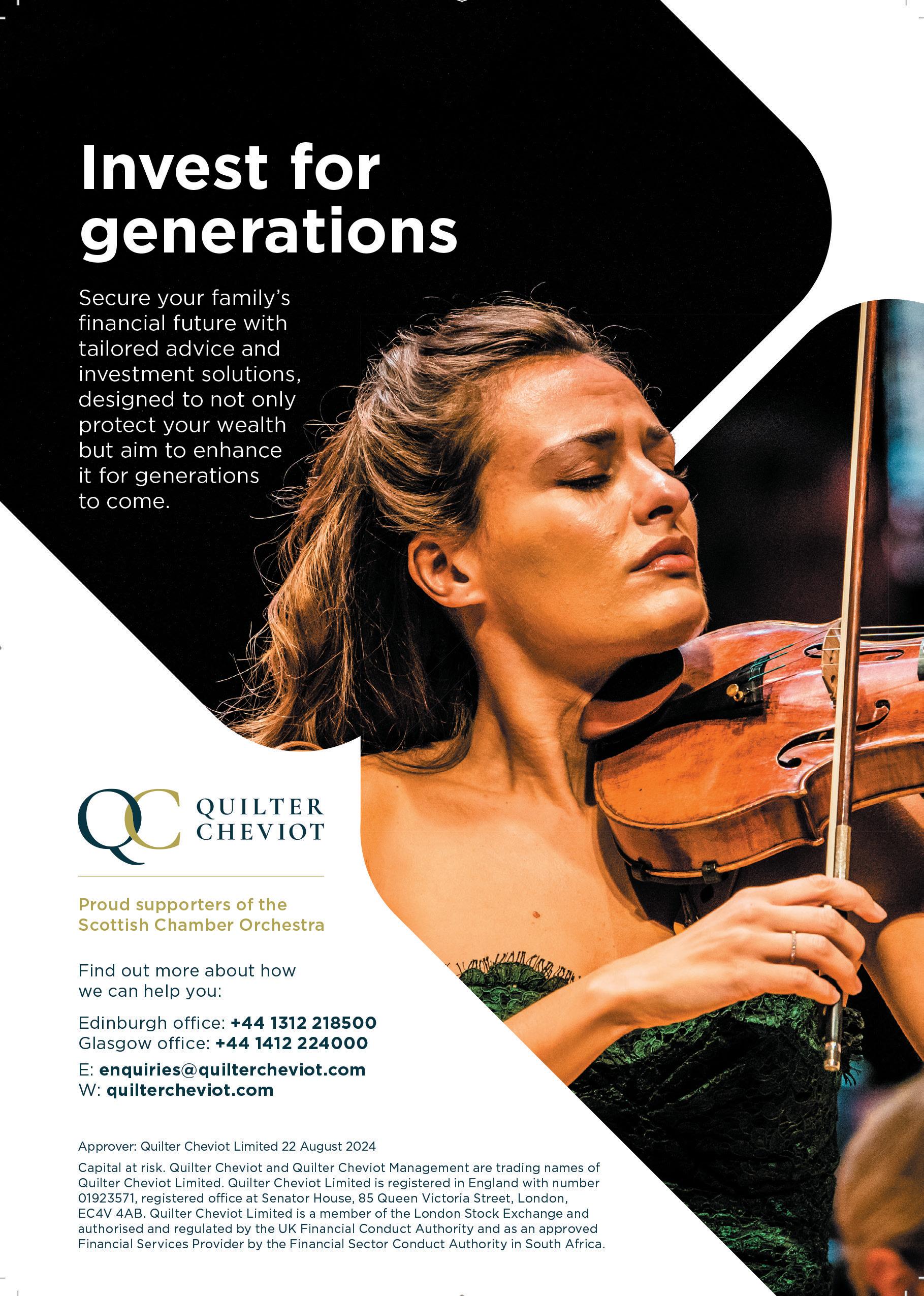

At the SCO, we deeply value our incredible community of regular donors.
Each year, we must raise £1.2 million to continue delivering outstanding musical performances on-stage and innovative education and community work off-stage. Every donation has a positive impact on our work, and, in return, we bring our donors closer to the Orchestra and our wonderful array of visiting artists.
For more information on how you can become a regular donor, please get in touch with Hannah on 0131 478 8364 or hannah.wilkinson@sco.org.uk
sco.org.uk/support-us